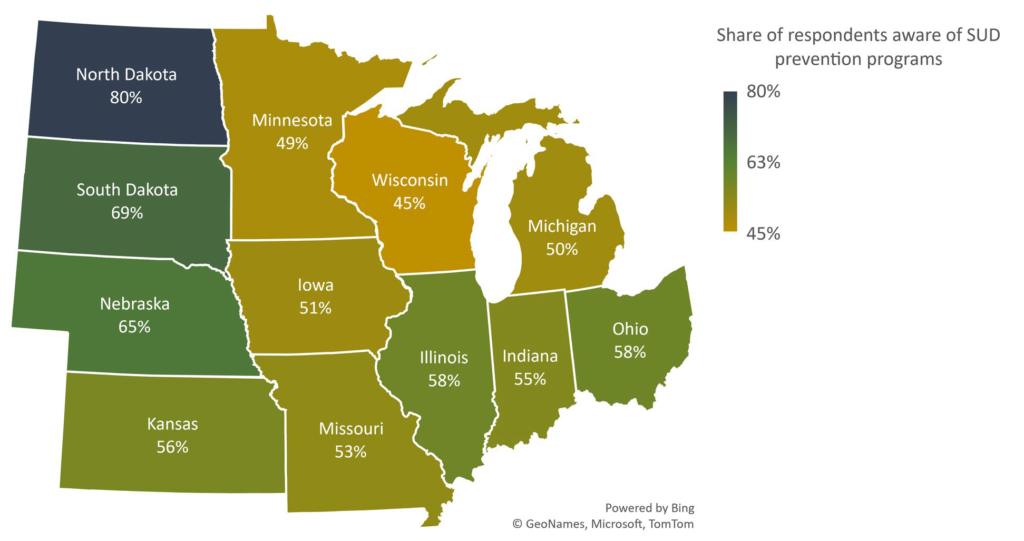By Zuzana Bednarik, Ph.D.
Substance abuse includes underage drinking, alcohol dependency, non-medical use of prescription drugs, abuse of over-the-counter medications, and illicit drug use.[1] As millions of Americans suffer from substance abuse, community-based prevention programs are essential to help prevent and reduce substance use disorder and misuse and support people to live healthier lives.
The main goal of community awareness is to increase the knowledge of the available programs and services provided by the community. Respondents participating in the NCR-Stat: Baseline Survey (2022) were asked about their awareness of community-based programs to prevent or reduce substance misuse and substance use disorders (SUD). [2] Overall, 54% of respondents reported that they were aware of community provided SUD-related programs, with a higher share of men than women aware of these programs (58% and 52%, respectively).
Survey results revealed differences between nonfamily and family households, especially households with children. Forty-nine percent of nonfamily households are aware of the community-based SUD programs compared to 56% of family households, out of which 66% have children under 25 years old living in the household.
The respondent’s age plays a role in the SUD program’s awareness. Figure 1 shows that the perception of SUD programs drops with the increasing age of a respondent. The most knowledgeable group comprises respondents between 18 and 34 years old. On the other hand, respondents 65 years and older reported the least familiarity with these programs.
Figure 1. Awareness of community-based substance use disorder prevention programs by respondent’s age (N=4,668)

Source: NCR-Stat: Baseline Survey, 2022.
Respondents with high school and lower educational attainment have the highest share of those who reported SUD program awareness (56%), followed by respondents with a four-year college degree and higher (55%) and those with college one to three years of college (50%).
Figure 2 indicates that the knowledge about the existence or non-existence of SUD programs in the community increases with income level. Fifty-two percent of survey participants with less than $25.000 of total household income in 2022 were aware of the community-based SUD programs compared to 59% of those with a household income of $100,000 or more.
Figure 2. Awareness of community-based substance use disorder prevention programs by respondent’s income category (N=4,502)

Source: NCR-Stat: Baseline Survey, 2022.
It is probably not surprising that 69% of respondents who stated that someone in their household suffered from substance use disorder are informed about SUD prevention programs in their community (compared to 50% of those without SUD-related issues).
If we drill deeper into the distribution of responses by race and ethnicity, the analysis reveals that most respondents of races other than White and Other races are highly aware of community SUD prevention programs (Figure 3). A similar situation occurs in the case of ethnicity, as Hispanic or Latino respondents demonstrated a higher SUD program awareness than Not Hispanic or Latinos. The share of SUD awareness in the Black or African American group reached 70%, followed by American Indian or Alaska Natives (69%) and the Hispanic or Latino group (67%).
Figure 3. Awareness of community-based substance use disorder prevention programs by respondent’s race and ethnicity (N=4,668)

Note: AIAN = American Indiana or Alaska Native. The category “Other races” includes Native Hawaiian and other Pacific Islanders. Source: NCR-Stat: Baseline Survey, 2022.
Our analysis uncovers different levels of SUD awareness between urban and rural areas in the NCR. Fifty-seven percent of rural respondents know whether the community offers SUD treatment programs compared to 52% of urban respondents. A closer look into residential locations shows that the share of SUD-aware respondents in towns with less than 2,500 people is the highest among different categories of residential locations. It is followed by open space rural areas (55%). The SUD awareness of urban respondents is 50% or higher in all urban residential locations (Figure 4).
Figure 4. Awareness of community-based substance use disorder prevention programs by respondent’s residential location (N=4,636)

Note: Based on the U.S. Census Bureau classification of urban and rural areas, we define rural areas as a) open and/or sparsely populated countryside (with population densities of less than 500 people), not within commuting distance to urban or suburban areas and b) towns of 2,500 people or less. Urban areas are specified as towns or cities with more than 2,500 inhabitants. Source: NCR-Stat: Baseline Survey, 2022.
Figure 5 shows disparities in SUD awareness between states in the NCR. The states with the highest share of respondents with knowledge of the SUD treatment programs in their communities include Nebraska (82%), North Dakota (81%), South Dakota (75%), and Ohio (65%). These four states have a high share of rural respondents informed about the programs compared to the percentage of urban respondents. For example, the difference between rural and urban SUD awareness is 22% in Nebraska, 9% in Ohio, and 8% in South Dakota.
Figure 5. Awareness of community-based substance use disorder prevention programs by respondent’s state in the North Central Region (N=4,228)

Source: NCR-Stat: Baseline Survey, 2022.
Summary
Respondents participating in our survey demonstrated high awareness of community-based programs to prevent or reduce substance misuse and substance use disorders. The topmost awareness was found between men and youth respondents, respondents with lower educational attainment, respondents with higher income, respondents living in rural areas, respondents with SUD history in their household, and BIPOC respondents.
References
[1] Youth.gov: https://youth.gov/feature-article/national-substance-abuse-prevention-month.
[2] Bednarikova, Z.; Marshall, M. I.; Wiatt, R. D.; Wilcox, Jr, M. D. (2022). North Central Region Household Data (NCR-Stat): Baseline Survey. Purdue University Research Repository. doi:10.4231/2DEM-Z333
For more information about substance abuse, see Substance Abuse and Mental Health Service Administration (SAMHSA): https://www.samhsa.gov/.
Author
Zuzana Bednarik, Ph.D., Research and Extension Specialist, North Central Regional Center for Rural Development
Download article
Suggested citation
Bednarik, Z. (2023, February 22). Community Awareness of Substance Use Disorder Programs in the North Central Region. North Central Regional Center for Rural Development. https://ncrcrd.ag.purdue.edu/2023/02/22/community-awareness-of-substance-use-disorder-programs-in-the-north-central-region/
